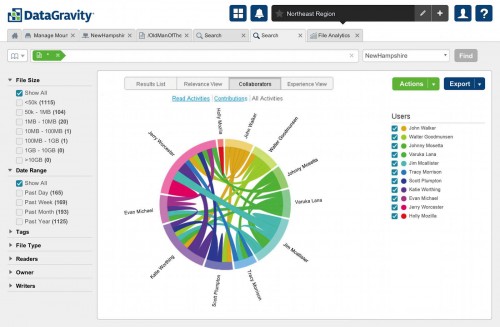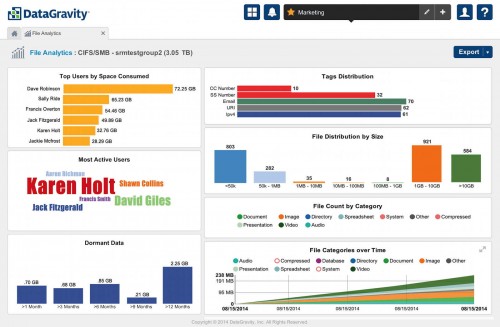The co-founder of Equallogic, Paula Long, is heading up the new startup DataGravity. Their system takes advantage of active/active controllers to bring deep storage inspection to small and medium businesses.
What they do
DataGravity brings a new level of information awareness to network storage arrays, enabling important new capabilities within the array at no extra cost:
- Full-text index of all documents.
- Automatic scanning for personally identifiable information such as credit card and Social Security numbers.
- Complete data access logging: who looked at what, when – handy for legal discovery.
- Multiple views of stored data by size, time, content and more.
- Even cooler: you can look at who is creating content and who is looking at it. Great for seeing the hidden info flows in a company.
DataGravity’s v.1 supports SMB, NFS, iSCSI and VMware.
How they do it
The key insight is that in any active/active system, all the metadata is replicated across both controllers. Commonly the 2nd data set is trashed once writes are fully committed.
But DataGravity saves that data from the 2nd controller. It’s a low-overhead way to capture the critical data.
Over that they have an easy-to-use GUI for array management and searching, filtering and presenting the data. I’d like to show you the coolest one – info flows between employees – but no graphics online. Update: Suzanne promptly got me what I wanted! Added below. End update.
The StorageMojo take
A storage array that tells you how your data is being used. Pretty cool.
The architecture is innovative and meets a real business need for smaller companies.
Assuming the product works as advertised – and I do – the only real question is how effectively DG can communicate the value proposition. EqualLogic had a simple value prop: storage automation and a complete feature set in one box for a fixed price. Easy to grasp.
DG’s “. . . storage, protection, data governance, search and discovery powered by an enterprise-grade hardware platform and patent-pending software architecture . . . .” seems like a harder sell. Maybe you have to see it to get it.
Similar functionality can be had with layered software at extra cost. How quickly those vendors will cede market share is a question.
Finally, in these social media drenched days, a significant share of communications takes place outside of the traditional storage infrastructure. Tracking tweets and IMs is a hole in the DG model.
But it’s way better than what’s out there and that will be enough for many businesses who’ve experienced the pain of legal discovery or worry about trade secret theft. Ultimately though this seems more like a feature than a market.
How will other network storage vendors react? Similar functionality, should DG gain traction, would seem to be within their capabilities as well.
Courteous comments welcome, of course.




Hi George,
Have you seen Varonis ? it does most of this (bar the text indexing) for any storage .
Regards,
Richard
Who is George?
Robin
Keeper Technology’s kSAFE product line with Intelligent Data Management Technolgy (IDMT) can handle these demands as well!